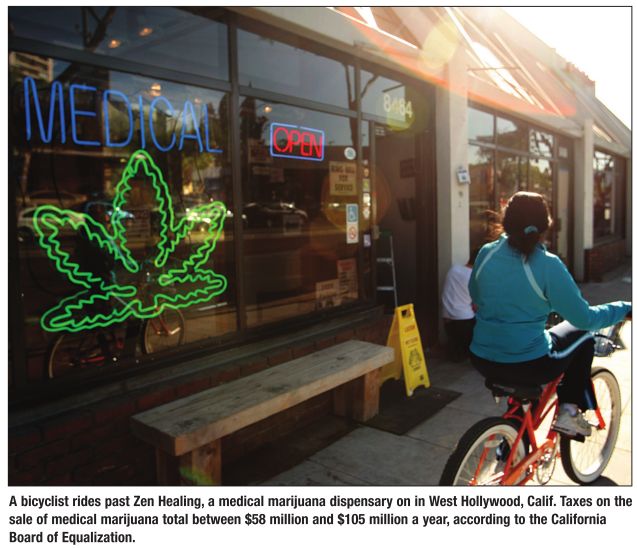
In December, government-funded researchers published a paper in the Journal of the American Medical Association showing that marijuana smoke isn’t nearly as harmful as cigarette smoke. Billed as the most comprehensive study ever on pulmonary health and pot, the study tracked 5,000 smokers over 20 years and found no decline in lung function in people who had smoked a joint a day for seven years. However, researchers found that lung function did decline after a decade of daily pot smoking.
“They were going to show that it was pretty harmful,” says Dan Linn, executive director of Illinois NORML, who noticed in high school that pot smokers on his school’s track team ran just as well, if not better, than teetotalers. “It showed the opposite.”
But Linn has no illusions. “I don’t think this is something that’s the final nail in the coffin of cannabis prohibition,” he says. “These kinds of studies have been coming out for almost as long as cannabis prohibition has been around.”
When a representative from the American Medical Association testified against a federal law against marijuana enacted in 1937, proponents of a ban countered with a pharmacology professor who said that pot provoked violence and caused brain damage. The professor subsequently testified as a defense expert in murder trials when pot-smoking defendants claimed insanity, once telling a jury that he had smoked weed himself and had been transformed.
“I thought I had wings,” the professor was quoted as testifying in a story on a murder trial published in the New York Post.
“Great big blue wings – and I was flying all around the world.”
“Nothing has shocked me when it comes to the history of cannabis prohibition,” Linn says. “Men growing breasts. Ax-murdering children.”
When it comes to banning reefer, Illinois beat the feds to the punch, making pot illegal in 1931, a half-dozen years before a national law was passed. And the Land of Lincoln remains tough on pot smokers.
Illinois ranked sixth in the nation in percapita marijuana arrest rates, according to a 2009 paper published by Gettman, who studied 2007 arrest statistics and found that 58 percent of all drug arrests in Illinois were for marijuana offenses. Statewide, marijuana arrests grew from 47,754 in 2003 to 54,756 in 2007, Gettman reported, an annual increase of nearly 3 percent. The Springfield Police Department had the 36th highest marijuana arrest rate of all Illinois police agencies with at least 62 marijuana arrests; the Sangamon County sheriff’s office had the 61st highest rate.
The logic behind some enforcement efforts is questionable.
Cook County has, by far, the highest marijuana arrest rate in the state, according to Gettman’s study, but in Chicago, 97 percent of charges involving 2.5 grams or less were dismissed between 2006 and 2010, according to a December story in the Chicago Sun-Times. During the same time period, 84 percent of cases involving between 2.5 and 10 grams were dismissed and 57 percent of cases involving up to 30 grams were thrown out. One defendant had 14 of his 16 possession charges since 1998 dismissed and received court supervision for the other two, the paper found.
In New York, the number of arrests for small amounts of marijuana has risen each year for the past seven years despite a law that allows arrests for small amounts only if the drug is displayed in public. Police critics say that arrests are rising due to a police tactic known as stop-and-frisk in which officers briefly detain people and order them to empty their pockets, ostensibly to keep guns off the streets, according to the New York Times. When someone pulls out pot, they get arrested, the newspaper reported, and people of color are
disproportionately busted because the tactic is most commonly applied in
minority neighborhoods. A sociologist who analyzed the data estimated
that the low-level pot arrests cost taxpayers $75 million.
The
Springfield arrest rate has dropped in recent years since the city
council in 2009 passed an ordinance that made possession of 2.5 grams or
less (there are 28 grams in an ounce) an ordinance violation –
essentially a traffic ticket. Previously, possession was a misdemeanor
punishable by up to a year in jail and a permanent mark on one’s
criminal record.
Officers
have discretion: They can still arrest someone under state law. But in
2011, most marijuana violations were handled in a kinder, gentler way,
with 111 people arrested under state law and 348 citations issued, each
carrying a $300 fine. It works out to $104,400 in city coffers.
“That’s
nothing to sneeze at,” says Ward 2 Ald. Gail Simpson, who sponsored the
ordinance that decriminalized possession of small amounts of pot.
Money wasn’t the primary motivator, Simpson says.
“I
did it [sponsored the ordinance] primarily because so many young people
use marijuana and they don’t think about the long-term consequences if
they get caught, based on the laws that are currently on the books,”
Simpson said. “My desire with regard to the ordinance I sponsored was to
help youth and to help the city. I think it served those purposes,
dually.”
Simpson said
she heard from no constituents who opposed her push to decriminalize
pot. She doesn’t answer yes or no when asked if she favors outright
legalization.
“Being a
child of the late 60s and early 70s, hey,” she says. “There are worse
things that people could do other than smoke marijuana. Do I partake?
No. Do I want my daughter to? No. Look: I don’t know that anybody has
come up with any long-term negative effects. … I think a lot of
communities and cities are looking at legalizing marijuana. I don’t know
that it would be any worse than alcohol.”
Economic consequences
Linn of Illinois NORML says that there is propaganda on both sides of the marijuana debate, as there is in any war.
Some folks overindulge and smoke pot all day when they should be doing more productive things, he says.
“It
can be abused,” Linn says. And some legalization proponents go too far
when they say that America’s addiction to foreign oil could be solved if
pot were legal and farmers grew proverbial amber waves of hemp that
could be converted into bio-diesel fuels, Linn allows. Economic benefits
are nuanced, he says.
“If
we were, tomorrow, to end cannabis prohibition, there’d be a lot of
jobs created, but there’d also be a lot of jobs taken away,” he says.
Legalization
could take away jobs from the drug-testing industry, police
departments, probation departments and prisons, Linn said, but, on
balance, he said that he believes there would be a net job gain.
Some of those jobs might have nothing to do with pot.
Being
a black-market commodity, marijuana costs more than it should, Gettman
said. If pot were legal, the price would go down and users would have
more money to spend on restaurants, electronics and all sorts of other
things, he said. Meanwhile, profits would be invested in legitimate
economic activity, he added.
As for how much tax revenue could be gained if pot were legal, Gettman says that no one can say.
“The problem is, we just don’t have all the data we need,” Gettman says.
In
California, taxes on the sale of medical marijuana total between $58
million and $105 million a year, according to the California Board of
Equalization, which collects taxes and estimates annual sales as high as
$1.3 billion.
According
to a 2005 study by Jeffrey Miron, a Harvard economics professor, taxes
on marijuana, if it were legalized, would total $2.4 billion a year
nationwide if the weed were taxed like other goods and $6.2 billion if
it were taxed at rates comparable to tobacco and alco hol.
Meanwhile,
state and local governments would save $5.3 billion on enforcement
costs and the federal government would save another $2.4 billion,
according to Miron’s study, which factored in revenue currently
generated by fines and forfeitures.
Reckoning
a $100 billion retail market, Gettman thinks that Miron’s tax estimates
are low, but he cautions that there are any number of variables.
“There’s
some things we just don’t know,” Gettman said. “We don’t know if
marijuana use is going to go up if we legalize. We also don’t know about
the elasticity of marijuana consumption, will people smoke more or
less.”
Like Linn, Gettman says that pot isn’t necessarily harmless.
“There
are people who have addictive and dependency problems with marijuana,”
Gettman says. “Marijuana does produce social costs. Right now, those
costs are being borne by the non-marijuana-using public. Whatever the
costs are, they should be borne by the people who use marijuana and
profit from marijuana sales.”
Despite
nearly 75 years of prohibition at the federal level, Gettman points out
that millions of Americans still smoke marijuana and studies indicate
that use is rising despite increasing arrests.
“Arrests
are not a control mechanism, they’re just a response,” Gettman says.
“The fact that we go out and arrest people, it doesn’t prevent marijuana
use. It’s just something we spend money on to make it look like we’re
doing something about a problem. The genie’s not going back in the
bottle. They can hold this thing off for awhile, but come on: What do
they have to point to?” From behind prison walls, Jason Spyres says that
marijuana is here to stay, and legalization is better than prohibition.
After all, he says, Anheuser-Busch doesn’t shoot up rival breweries,
but gangsters involved in the marijuana trade are killing people in
Mexico. Sooner or later, he says, reason will prevail.
“As
far as the state of Illinois goes, we will eventually have taxation and
regulation of marijuana,” Spyres predicts. “I will be long out of
prison by then.”
Contact Bruce Rushton at [email protected].